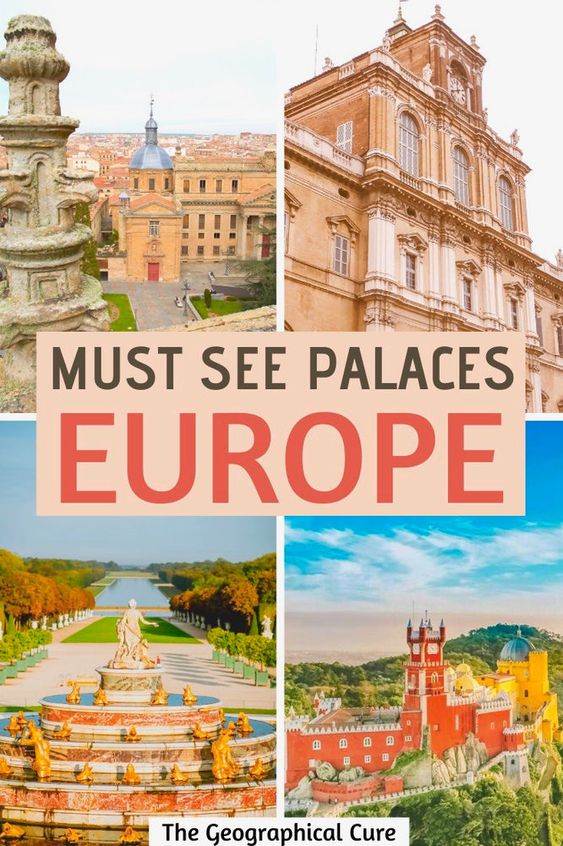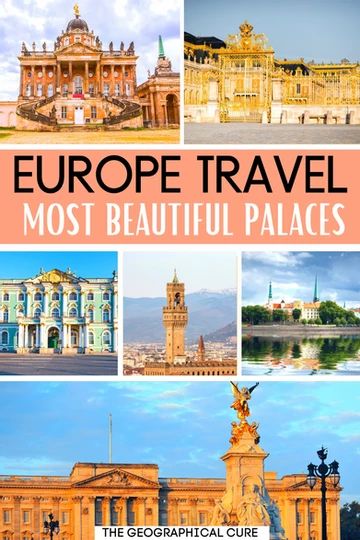Need some destination inspiration for a trip to Europe? Here’s my guide to the most beautiful palaces in Europe.
No one does palaces quite like Europe. They are unrivaled in their opulence and grandeur. So, if you need a dash of royalty or some guilty pleasure escapism in your life, this guide should do the trick.
Once (or still) home to kings, popes, emperors, and aristocrats, these palaces represent Europe’s finest and most lavish architecture.
25+ Best Beautiful Palaces In Europe
Here are my picks for the 26 gorgeous palaces that you should put on your Europe bucket list.
1. Schönbrunn Palace, Vienna Austria
Schoenbrunn is a swishy Renaissance palace in Vienna. It was the summer home of the Hapsburg dynasty.
They were the dynasty that governed the Austro-Hungarian empire for almost six and a half centuries. Schönbrunn, boasting an astounding 1441 rooms, now opens its doors to the public with access to 40 of them.
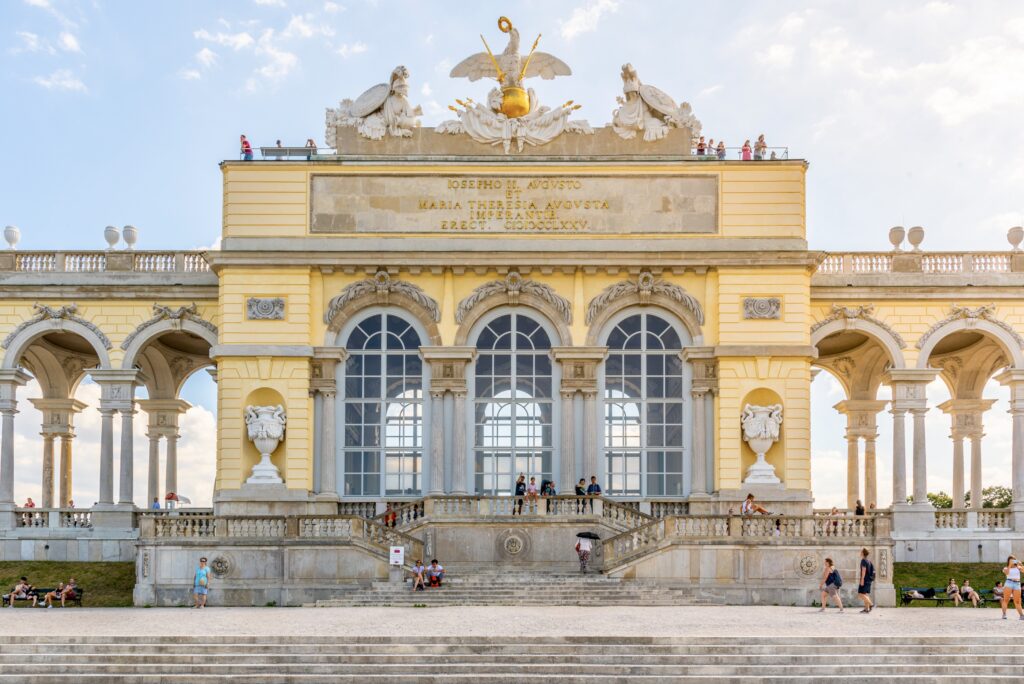
During the ‘Imperial Tour,’ visitors can explore 22 rooms, including the splendid imperial chambers of Emperor Franz Joseph and the renowned Empress Sisi.
For those opting for the ‘Grand Tour,’ 18 additional rooms are accessible. They include the 18th-century interiors from the era of Maria Theresa, the visionary behind Schönbrunn’s creation.
Notably, the Mirror Room is where Mozart famously performed his debut concert at the tender age of six
>>> Click here to book a skip the line ticket
2. Pope’s Palace, Avignon France
News Blast! The popes haven’t always lived at the Vatican. I had long forgotten this little factoid until I plotted an itinerary for my recent southern France road trip.
From 1309-77, the popes lived in the Palais des Papes in the enchanting riverside town of Avignon, rather than in Rome. That period was called the “Avignon Papacy.” Six papal conclaves were held there before the popes returned to Rome.
Built in 1335-52, the Pope’s Palace is the largest Gothic building in western Europe. The imposing facade resembles medieval fortified churches. Highlights are the Pope’s private apartments, the Matteo Giovannetti frescoes, and the soaring chapel.”
The Pope’s Palace is the 10th most visited site in France. Click here to book a guided walking tour that includes the palace.
READ: One Day In Avignon Itinerary
3. Schloss Neuschwanstein, Schwangau Germany
Clad in glistening limestone and strategically perched in the Alps, Neuschwanstein Castle is the most visited palace in Germany and one of Europe’s most popular sites.
With its majestic turrets, decadent interior, and dramatic backstory, Neuschwanstein is essentially the embodiment of a fairy tale. A fairy tale spun by a daydreaming king, Mad King Ludwig of Bavaria.
Ludwig was a reclusive king, loner, and possibly a misanthrope. Ludwig didn’t care much for affairs of state either. Instead, his life work was his pathological obsession with castle building, something you might expect from a “mad” king.
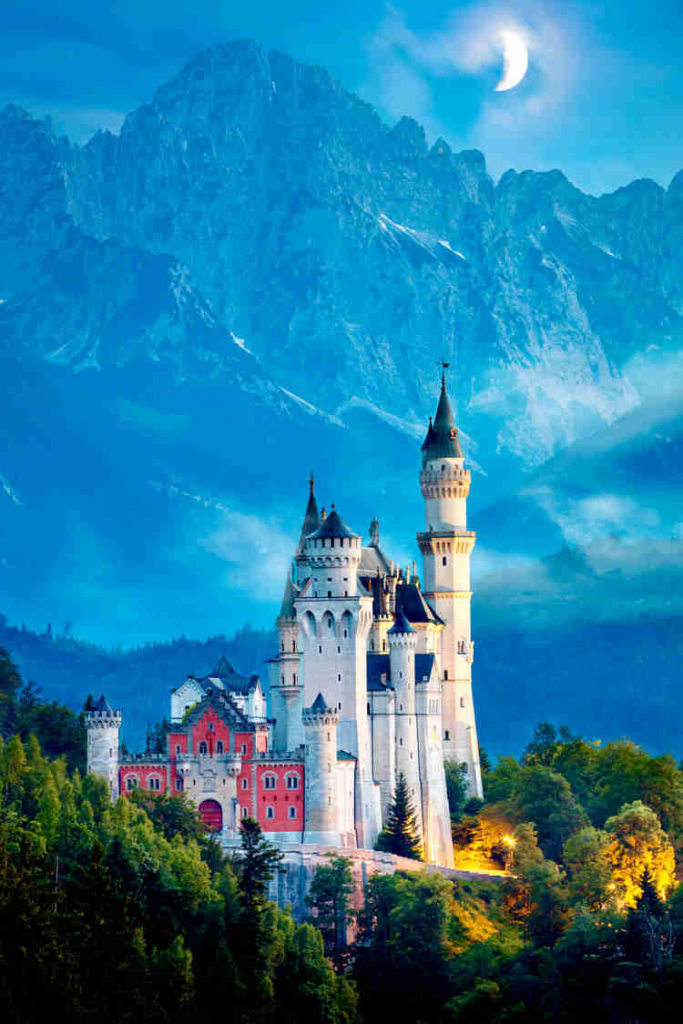
Neuschwanstein took 24 years to build. It’s a prime example of 19th century Romantic style architecture, sprinkled with numerous tower, gables, turrets, and balconies.
Inside, it’s full of vibrant color and depicts scenes from Richard Wagner’s operas. The highlights are the Throne Room, Singer’s Hall, and Ludwig’s fancy bedroom.
You can take a virtual tour of Neuschwanstein on Google Arts & Culture or on the Neuschwanstein website here.
>>> Click here to book a timed entry skip the line ticket
4. Pena Palace, Sintra Portugal
Pena Palace is a fancy 19th century palace in Sintra, just a short 30-minute day trip from Lisbon. It’s a UNESCO World Heritage Site and a famous spot in Portugal.
People really love Pena Palace because it’s the most romantic palace you can imagine.
What makes it special is that it’s super colorful and mixes all sorts of different architectural styles.
It’s like several castles mashed together. You’ll see onion domes, turrets, walls with gaps on top, and funny-looking gargoyles. It’s quite a sight
Pena Palace was commissioned by King Ferdinand II in 1842, possibly in an attempt to rival Neuschwanstein Castle. The palace’s facade serves as a color-coded legend.
The red portion of the castle is the oldest part. The ochre or yellow arches and domes showcase the Moorish influence. The blue tiled structures are reminiscent of the Manueline style.
Here’s my complete guide to visiting Pena Palace. You’ll definitely need to book a skip the line ticket to visit.
READ: 4 Day Itinerary for Lisbon
5. Royal Chateau de Chenonceau, Loire Valley France
Built in the 16th century, the Chateau de Chenonceau is the most famous and romantic of chateaux in the Loire Valley. It spans the River Cher with picturesque palace arches for boats to glide under.
Chenonceau housed and was influenced by many famous women over the centuries — Diane de Poitiers, Catherine de’ Medici, and Louise Dupin. Hence, it’s nicknamed the “Ladies Chateau.”
Highlights of the meticulously maintained chateau are the lavishly decorated ceilings, the ornate chapel, the Grand Gallery, the bedroom of Diane de Poitiers, and the Medici Gallery (now a museum). The museum houses Old Master paintings by Rubens, Pouissin, and Tintoretto.
Chenonceau has partnered with Google Arts & Culture. So you can take an extensive virtual tour, read stories about the historic chateau, or examine the art collection here.
>>> Click here to book a skip the line ticket
6. Winter Palace, St. Petersburg Russia
The Winter Palace was the official home of the Russian imperial family until the Russian Revolution in 1917. Commissioned by Empress Anna, construction of this monolith began in 1732.
When Catherine the Great took the throne in 1762, she completely redid the interiors. The palace continued to be embellished through the 19th century.
Today, the Winter Palace houses the State Hermitage, one of the world’s best museums. It’s the second largest museum in the world with a slew of masterpieces.
The Hermitage’s most significant pieces include Faberge eggs, sculptures (especially Canova’s Three Graces and Psyche Revived by Cupid’s Kiss), and jewelry.
7. Palace of Versailles, Versailles France
The Palace of Versailles was built by the Sun King Louis XIV, the Palace of Versailles is the most ornate and famous royal palace in France, located just outside Paris.
One of its most renowned features is the Hall of Mirrors. It’s a dazzling room adorned with 357 mirrors, magnificent chandeliers, and majestic windows that reflect the grandeur of the past.
You can also tour the king’s apartments, the queen’s apartments, the royal chapel, and the rooms of Hercules and Mars.
Outside, the palace boasts vast, meticulously manicured gardens replete with fountains, sculptures, and expanses of pristine lawns. Nearby, the Grand Trianon, a separate royal residence, offers an elegant retreat from the main palace.
Exploring the palace grounds, you can also visit the charming Hamlet, Petit Trianon, and Queen’s Hamlet, once private sanctuaries of Marie Antoinette. Steeped in history,
For the full scoop on everything you can see and read online, here’s my guide to taking a digital tour of the Palace of Versailles. If you want to virtually tour other famous chateaux, here’s my guide to glamorous chateaux in France.
>>> Click here to book a full access ticket
8. The Alhambra, Granada Spain
The Alhambra is the world’s last and greatest Moorish fortress. The UNESCO-listed Alhambra sits on a stunning piece of real estate – a high, mountainous location on Sabika Hill with sweeping views over the city of Granada and the surrounding countryside.
The Alhambra began as a small fortress in 889 A.D. In 1232, the first Nasrid sultan, Mohammed I, established a royal residence when he came to power.
In 1492, the Moors fell. King Ferdinand and Queen Isabella reclaimed the Alhambra and transformed it into a royal palace.
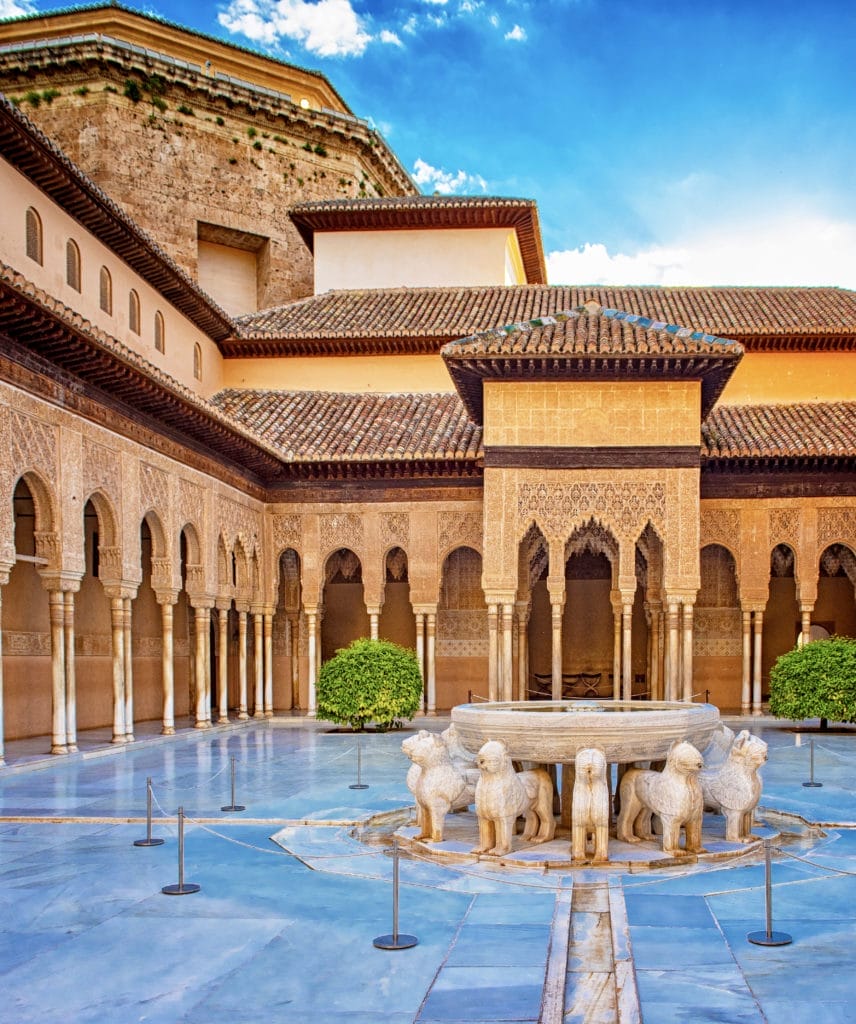
The Alhambra became a UNESCO site in 1984. There are four must see sites: the Nasrid Palace, Charle’s V Palace, the Alcazaba, and the Generalife Gardens.
The Nasrid Palace is the over the top ornate highlight. It boasts incredibly beautiful Moorish ceilings and ornate plasterwork.
The enchanting Generalize Gardens feature carefully laid-out paths, terraces, and cascading water elements. The Courtyard of the Maidens is gorgeous — a rectangular pool surrounded by meticulously detailed arches, columns, and delicate stucco work.
Here’s my complete guide to visiting the Alhambra. You’ll need to pre-book a skip the line ticket well in advance of your visit.
9. Doge’s Palace, Venice Italy
Set in St. Mark’s Square, the Doge’s Palace or Palazzo Ducale is the very symbol of Venice. This pink and white marble Gothic-Renaissance building was the official residence of the doges.
They ruled Venice for more than 1,000 years. It once held Casanova in a cell, but he dramatically escaped.
Opulent living defined the palace, with lavish decorations and grand scale designed to awe. Leading artists adorned countless walls. Yet, for prisoners in the palace’s piombi, it was a place of horror, marked by harsh conditions, poor ventilation, and extreme temperatures due to the metal roof
Aside from the gorgeous rooms and staircases, there’s some fantastic works of art on display: Veronese’s Rape of Europe and The Triumph of Venice, many paintings and ceilings by Tintoretto, and Tiepolo’s Neptune Bestowing Gifts upon Venice.
Here’s my complete guide to the Doge’s Palace. Click here to book a skip the line ticket. I also highly recommend the secret itineraries tour where you can see the prisons and other secret places.
READ: 2 Days in Venice Itinerary
10. The Belvedere Palace, Vienna Austria
The Belvedere Palace is one of Vienna’s most visited tourist spots and an important UNESCO site for its showy architectural ensemble.
The Belvedere was designed by renowned Baroque architect Johann Lucas von Hildebrandt between 1712-23. It served as the summer residence for the legendary military leader Prince Eugene of Savoy.
Today, the palace is one of the best museums in Vienna, housing a rich collection of 19th and 20th-century Austrian and Baroque art.
Its main claim to fame is the world’s largest collection of Gustav Klimt paintings, including the world famous The Kiss.
It also boasts masterworks by Egon Schiele and Oskar Kokoschka, two important Expressionist painters.
If you like Klimt’s gold toned art nouveau pieces, I also have a guide to the Klimt Trail in Vienna.
>>> Click here to book a ticket to the palace
READ: 3 Day Itinerary for Vienna
11. The Palacio Real, Madrid Spain
The Royal Palace of Madrid is the official residence of the Spanish Royal Family. But they actually live in the more modesst Palacio de la Zarzuela. The Palacio Real is only used for state ceremonies.
The palace was built on the site of a Moorish alcazar after it burned down in 1734. The palace somewhat resembles the Louvre in style.
There are are over 3,000 rooms inside. Visitors have access to 50 rooms, including the lavish state rooms, the throne room, the royal chapel, and the Hall of Columns.
Not only are the furnishings sumptuous, but the palace is filled with some great art work by the likes of Goya, Velazquez, El Greco Peter Paul Rubens, Tiepolo, and Caravaggio.
>>> Click here to book a fast track ticket
READ: 2 Days in Madrid Itinerary
12. Buckingham Palace, London England
Buckingham Palace may be the world’s most famous royal home. It’s the official residence and administrative headquarters of the British monarch.
This iconic building has served as the monarch’s London residence since Queen Victoria’s accession in 1837. The palace is not only a symbol of British monarchy but also a popular tourist attraction known for the Changing of the Guard ceremony, stunning State Rooms, and the beautiful Buckingham Palace Gardens.
It’s also the site of royal weddings, jubilees, and the changing of the guards. The most magnificent bits are the Grand Staircase, the Throne Room, the White Drawing Room, and the Blue Drawing Room.
Aside from the sumptuous royal furnishing, Buckingham Palace houses an impressive art collection. It features work by Rembrandt, Vermeer, and Canaletto.
>>> Click here to book a ticket to the palace’s state rooms
READ: 5 Days in London Itinerary
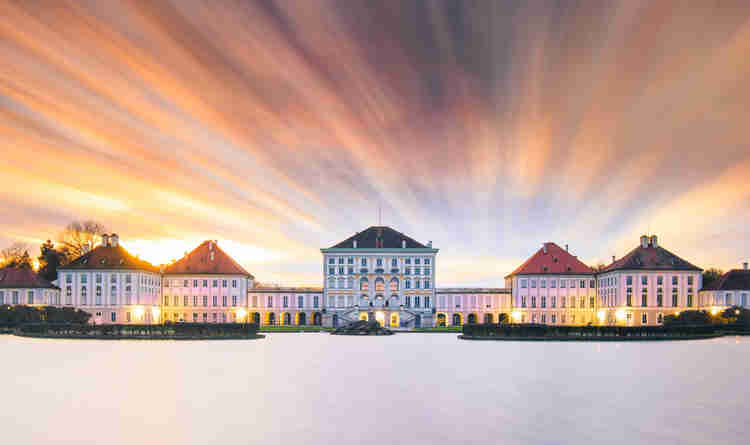
13. Nymphenburg Palace, Munich Germany
The beautiful Nymphenburg Palace is just 30 minutes outside Munich. It served as the splendid summer residence for the Wittelsbach dynasty and was originally constructed to commemorate the birth of a Bavarian heir.
Built in the 17th century, Schloss Nymphenburg ranks among Europe’s largest and most beautiful palaces. It’s a grand villa flanked by two expansive wings.
Inside, you’ll discover intricate parquet floors, vibrantly painted ceilings, an abundance of paintings, and rooms exquisitely adorned in period style.
The central villa boasts two remarkable highlights: the dazzling Stone Hall, adorned with frescoes featuring nymphs, and the Gallery of Beauties, where King Ludwig I (the grandfather of Mad King Ludwig II) showcased his portraits of captivating women
There are quite a few lovely mini-schlosses sprinkled throughout Nymphenburg Palace Park. These tiny follies were where the Wittelsbachs escaped when courtly life proved too annoying.
The most famous folly is the glittering Amalienburg, the best example of Rococo Architecture in Germany.
>>> Click here to book a guided tour of the palace
14. Wurzburg Residence, Wurzburg Germany
Wurzburg is a delightful UNESCO town in northern Bavaria. Aside from its adorable medieval streets, it’s the home of the famous Wurzburg Residence.
This ornate palace was home to the Wurzburg bishop-kings, who aimed to build an eye popping spectacle akin to Versailles.
The palace is so glamorous that it’s been dubbed the “German Versailles.” In 1720, prince-bishop Johann Philipp Franz von Schönborn commissioned the residence. The palace took 60 years to build.
The highlights are the intricate stucco work throughout the palace, the magnificent frescos a Tipeolo(a famed Italian Rococo artist), and the visually stunning White Hall.
Here’s my guide to the Wurzburg Residence.
15. Drottningholm Royal Palace, Sweden
Built in 1600, Drottningholm Palace is the best-preserved castle or palace in Sweden. The Baroque structure still serves as the King and Queen’s permanent residence and setting for official receptions.
Inspired by Versailles (like so much else), Drottningholm Palace has over 600 rooms. It’s especially renowned for the Chinese Pavilion and the Palace Theater. The unique architecture showcases the changing tastes of the royals over the centuries.
The palace is beautifully situated on a island. Now, you don’t have to hop on a boat to peak inside.
You can take a virtual tour of the palace here.
16. Royal Palace of Caserta, Naples Italy
The incredible Palace of Caserta is a UNESCO site in Naples. Built by King Charles VII of the House of Bourbon, it was used as the main residence of the kings of Naples. With over 1200 rooms, the palace was one of the largest palaces in 18th century Europe.
The sprawling palace complex was built on a grid with four outer wings. You enter via the Grand Staircase of Honor, surrounded by marble.
The palace is lavish inside, especially the gold filled throne room. Caserta Palace comes complete with stunningly beautiful gardens, with long reflecting pools and statuary.
Interestingly, the palace was a filming location for Mission Impossible III. You can take a virtual tour of the palace here.
>>> Click here to book a ticket
17. Hampton Court Palace, Molesey England
London’s Hampton Court Palace is the world’s greatest surviving medieval palace. And it has a deliciously rich and scandalous history.
Hampton Court Palace was the favored retreat and leisure destination for England’s infamous King Henry VIII and other prominent figures in English history.
A significant turning point in Henry’s life occurred at this palace when he suffered an injury, dramatically altering him from a charismatic and energetic king to a tyrannical figure.
Hampton Court Palace is a fascinating blend of two distinct palaces. It combines the Gothic Palace, initially built by Cardinal Wolsey and later inhabited by Henry VIII, with the Baroque Palace constructed by the Stuart monarchs, William and Mary.
This royal residence was in use from the early 1500s until the 1730s. Highlights include the Great Hall, the Cumberland Gallery, the Mantegna Gallery, and the cartoon for the Raphael Tapestries in the Vatican.
Here’s my complete guide to visiting Hampton Court Palace. Click here to pre-book a ticket.
18. Munich Residence, Munich Germany
The Munich Residence is Munich’s #1 attraction. The Residence was the luxe city palace and seat of government of the Wittelsbach dynasty. The clan ruled Bavaria for over 700 years, for better or worse.
Their Versailles-like palace is awash in tapestries, swirly Rococo gilt, quirky reliquaries, and grottos. In fact, the palace has so many tapestries, you might give up admiring them out of sheer visual overstimulation.
The Residence is now a museum. But it’s really just a lavishly decorated palace, for the most part.
The Residence is a hodgepodge mix of architectural styles — Renaissance, Baroque, Rococo, and Neo-Classicism. But that’s befitting a palace that lorded over Bavaria for over 700 years.
Inside, the Residence has of over 120 rooms. Highlights include the Shell Grotto, the Anitquarium, the Ancestral Gallery, the Green Gallery, and the Ornate Room.
Here’s my complete guide to visiting the Munich Residence.
>>> Click here to book a guided tour
19. Schloss Sanssouci, Potsdam Germany
This 18th century palace is synonymous with Frederick the Great, King of Prussia. Sanssouci is a French word that means “without concern.” That’s how Frederick envisioned his palace — as a place where he could escape court life and the burdens of royal duty.
Like the Wurzburg Residence, Sanssouci is sometimes considered the Versailles of Berlin. Though it’s much smaller than Versailles, and built in a Rococo style.
The palace gardens are also exquisite with fountains, vineyards, and Baroque terraces. The park also contains the Neue Palace and the exotic Chinese House.
20. Prince’s Place of Monaco, Monaco
The Grimaldi family has lived in the Prince’s Palace of Monaco for more than seven centuries. It was upgraded to a royal residence in the 15th century. As a result, the palace reflects the history of both the family itself and of Monaco.
The palace is a mix of Medieval, Renaissance, and Baroque architecture. Like many palaces, it has a Hall of Mirrors modeled after Versailles.
The palace was seized during the French Revolution. But it was restored to the Grimaldis in 1814 and they retrieved the stolen art work.
The Grimaldi family, rather like the Kennedy’s, is reputed to suffer from a “curse” beginning in the 13th century. A string of scandals, divorces, infidelity, death, and heartbreak have plagued the family. Most notably, actress turned princess Grace Kelly was killed in a tragic car accident.
The palace is perched on a cliff-like promontory. From the top, you have a royal panoramic view.
21. Palazzo Doira Pamphilj, Rome Italy
The Doria Pamphilj is a lavish 17th century Roman-Rococo palace in Rome. It began life as the humble Aldobrandini Palace.
But Camillo Pamphilj greatly expanded and decorated the palace. It has over 1000 gorgeous rooms, including a Hall of Mirrors. The heirs still live in the palace.
The Doria Pamphilj also operates as a museum with an incredible art collection. The Doria Pamphilj boasts over 650 works spanning the 15th to the 18th centuries.
This includes pieces by Velazquez, Raphael, Bernini, Caravaggio, Titian, Carracci, and Bruegel. Velazquez’s Portrait of Innocent X is world renowned and has a dedicated room in the palazzo.
Here’s my guide to visiting the Palazzo Doria Pamphlij. Click here to book a ticket.
READ: Guide To Rome’s Palace Museums
22. Hofburg Palace, Vienna Austria
The Hofburg Palace is a must see site in Vienna and one of the world’s biggest and most lavish palace complexes. The Hapsburgs lived there for centuries, until 1918. The Hofburg is still the residence of the President of Austria.
There are three parts of Hofburg Palace that you can visit: the Sisi Museum, the Imperial Apartments, and the Silver Collection. While the apartments are sumptuous, rivaling Schönbrunn, the Sisi Museum is the most fascinating part of a visit.
The Sisi Museum, established in 2004, is a stylish and somewhat cult-like destination devoted to the admirers of Empress Elisabeth.
This unique museum offers insights into the life of the “misunderstood” princess, whose tragic story bears resemblance to that of modern-day Princess Diana. Her life has inspired numerous books and films, and the museum illuminates her intriguing history
>>> Click here to book a ticket to the palace and museum
23. Palazzo Vecchio, Florence Italy
The Palazzo Vecchio, steeped in history, once served as Florence’s seat of power, housing the City Council that governed the Republic of Florence. Today, it has been transformed into a museum.
Located in the renowned Piazza della Signoria, the square is adorned with numerous sculptures, some of which are famous originals and others are copies, including Michelangelo’s David.
Inside the palace, you can explore the first-floor Hall of the Five Hundred, adorned with breathtaking frescoes by Giorgio Vasari.
Upstairs, you’ll find the opulently decorated private rooms of the Medici family.
The beautiful Vasari frescos in the Apartment of the Elements have been recently restored. You’ll also find Donatello’s groundbreaking Judith and Holofernes sculpture in the Hall of Lilies.
If you’re up for a climb of 400 steps, the Tower of Arnolfo offers 360 views. You enter via the Museum of Palazzo Vecchio, with a combined ticket for Palazzo Vecchio or for an additional small fee.
Here’s my complete guide to the Palazzo Vecchio. Click here to pre-book a ticket.
24. Pitti Palace, Florence Italy
The magnificent Palazzo Pitti is one of Florence’s most stunning architecture gems. Built in 1457, it was designed by Brunelleschi and built for the Florentine banker Luca Pitti, a Medici rival.
However, as often happened, the palace eventually fell into the hands of the Medici family. In 1549, the wife of Cosimo de’ Medici acquired the Pitti Palace, making it the Medici’s primary private residence and their third palace in Florence.
The Medici family undertook extensive expansions and added eight art galleries within its walls. Inside, you’ll find the Royal Apartments, which showcase styles from three different periods of ownership.
The most significant space is undoubtedly the Palatine Gallery, occupying the left wing of the first floor.
Here, you’ll discover an impressive collection of over 500 paintings, densely arranged amidst lavish furnishings. There are works by Raphael, Titian, Rubens, Caravaggio, and other European and Italian painters.
Be sure to check out Botticelli’s and Lippi’s Madonna and Child in the Prometheus Room. Two of Andrea del Sarto’s massive Assumption of the Virgin are in the Iliad Room. And, one of my favorites, Artemisia Gentileschi, has another version of Judith in the Saturn Room.
If you want to know more, here’s my guide to visiting the Pitti Palace. You’ll want to pre-book a skip the line ticket.
25. Te Palace, Mantua Italy
This extraordinary Palazzo Te in Mantua was designed and decorated by the talented artist-architect Giulio Romano, Raphael’s favorite pupil.
This beautiful palace in Europe was the extravagant summer retreat of the Gonzaga family. It’s a testament to the themes of love and desire.
The palace was commissioned by Federico II, the pleasure-loving son of Isabella d’Este. It provided him with a luxurious escape from the constraints of court life, enabling him to distance himself from his wife and mother, who resided at the Ducal Palace.
The palace’s interior is a mesmerizing showcase of Mannerist frescoes, painted by Romano between 1525 and 1535. These lavish artworks show off his artistic brilliance.
The Sala dei Cavalli, or Hall of the Horses, is the banquet hall where the Gonzaga were surrounded by paintings of their favorite prize-winning horses.
Gray and brown horses stand in profile, looking almost 3D. They’re almost life size, set against faux marble walls and landscapes.
The Sala of Psyche is the most opulent room, filled with erotic paintings bordering on debauchery. The frescos depict Cupid and Psyche and the theme of forbidden love. The mythological pair are a stand in for the forbidden love of Frederico and his mistress (also named) Isabella.
The most over-the-top room is the Hall of Giants. It depict a dramatic battle between giants and the gods from Greek mythology. It’s a dynamic composition that shows Roman’s mastery of foreshortening.
Here’s my complete guide to visiting Te Palace.
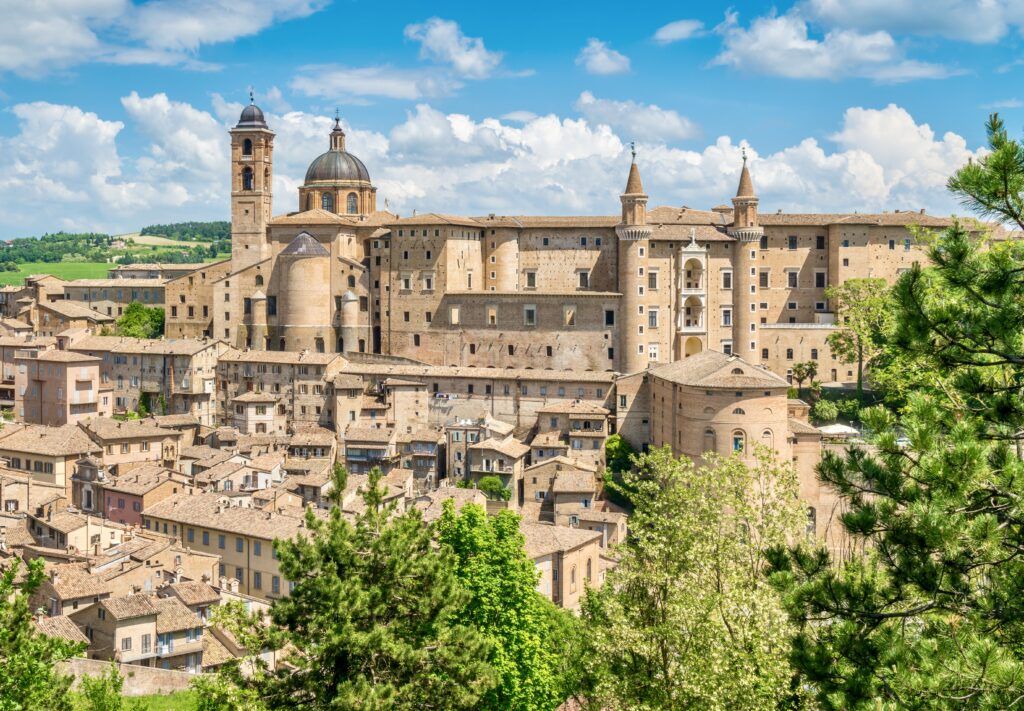
26. Ducal Palace, Urbino
Last but not least is the Ducal Palace in Urbino. Urbino was one of the most famous court cities of the Renaissance, led by the fiercesome Duke of Montefeltro.
The palace is a beautiful example of Renaissance architecture. It’s western facade is particularly eye catching, with a central loggia and delicate twin towers.
The palace doesn’t have many original furnishings. But it makes up for that with a magnificent wood inlaid studiolo (or study) and some standout Renaissance paintings by Raphael, Giovanni Santi, Titian, Paolo Uccello and Piero della Francesca.
READ: One Day In Urbino Itinerary
I hope you’ve enjoyed my guide to the most beautiful palaces in Europe. You may enjoy these other Europe travel guides and resources:
- Most Beautiful Secret Town in France
- Most Beautiful Secret Towns in Spain
- Most Beautiful Towns in Germany
- Most Beautiful Towns in Andalusia
- 45 best UNESCO Sites in Europe
- Famous landmarks in Spain
- Famous landmarks in Italy
- Famous landmarks in Portugal
- Famous landmarks in France
If you’d like tour Europe’s most beautiful palaces, pin it for later.

